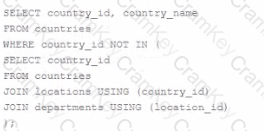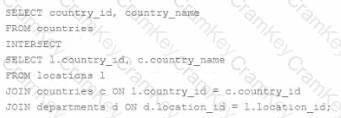Oracle Database 12c SQL
Last Update Jan 3, 2026
Total Questions : 326
To help you prepare for the 1z0-071 Oracle exam, we are offering free 1z0-071 Oracle exam questions. All you need to do is sign up, provide your details, and prepare with the free 1z0-071 practice questions. Once you have done that, you will have access to the entire pool of Oracle Database 12c SQL 1z0-071 test questions which will help you better prepare for the exam. Additionally, you can also find a range of Oracle Database 12c SQL resources online to help you better understand the topics covered on the exam, such as Oracle Database 12c SQL 1z0-071 video tutorials, blogs, study guides, and more. Additionally, you can also practice with realistic Oracle 1z0-071 exam simulations and get feedback on your progress. Finally, you can also share your progress with friends and family and get encouragement and support from them.
Examine the description of the countries table:

Examine the description of the departments table:

Examine the description of the locations table:

Which two queries will return a list of countries with no departments?
A)

B)

C)

D)

Examine the description of the MEMBERS table;
SELECT city,last_name LNAME FROM members …
You want to display all cities that contain the string AN. The cities must be returned in ascending order, with the last names further sorted in descending order.
Which two clauses must you add to the query?
Examine the data in the PRODUCTS table:

Examine these queries:
1. SELECT prod name, prod list
FROM products
WHERE prod 1ist NOT IN(10,20) AND category _id=1;
2. SELECT prod name, | prod _ list
FROM products
WHERE prod list < > ANY (10,20) AND category _id= 1;
SELECT prod name, prod _ list
FROM products
WHERE prod_ list <> ALL (10, 20) AND category _ id= 1;
Which queries generate the same output?